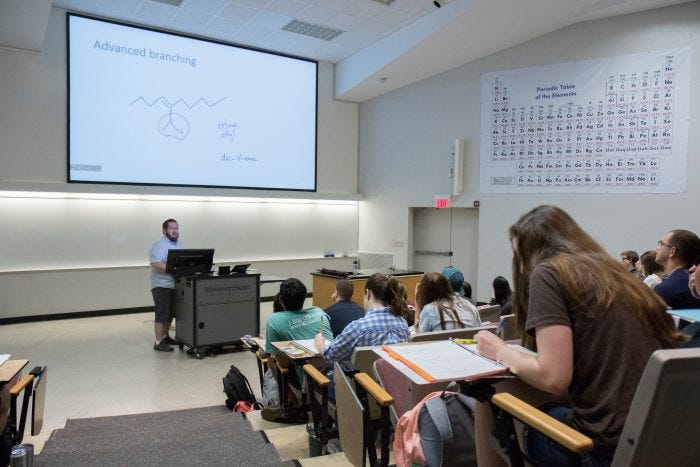STEM teaching deserves recognition
New idea to recognize a distinct workforce deserves consideration
This appeared on my blog over at Science.
Most of the ills that attend science today—racism, sexism, and homophobia in the science workforce; underrepresentation of marginalized groups in science; scientific misconduct; political naïvety of scientists; and more—originate in problems with teaching science, technology, engineering, and mathematics (STEM). For decades (or longer), faculty and administrators in US institutions of higher education have wrung their hands over this problem. How do we value teaching along with research? How do we value teaching in tenure and promotion? How do we include fixed-term faculty in major academic decisions? And on and on.
The reasons this problem is intractable are not mysterious. Universities tell two completely different stories about this. One story, generally found on admissions websites, boasts “Come to our university as an undergraduate and experience world-changing instruction from great scholars.” The other story, told mostly in meetings of research-active, tenured faculty, focuses on “How do we get more research done and climb in school rankings that are based on outside funding and publications?” Both angles are worthwhile, but no one wants to acknowledge how much conflict there is between them. Most institutions would say publicly that research and teaching are equal, but their actions and resource allocation clearly favor research. It is not uncommon—and a big mistake in my view—to see hiring committees for university presidents set a goal of attaining membership in the Association of American Universities (AAU), something that happens so infrequently and with so much emphasis on research that it distorts any strategic plan that truly values an institution for its actual strengths.
So, a beleaguered university president who has been told by the institution’s board to get into the AAU doesn’t have adequate resources to both invest in education and build up enough research to join the club. This has led to the current two-tier system, where the lower tier of teaching faculty includes underfunded graduate teaching assistants, with all of the attendant crises of late, exemplified most recently by the enormous strike at the University of California. But it also extends to full-time teaching faculty and part-time adjuncts (I myself am an adjunct professor at George Washington University and member of the adjunct faculty union).
Endless plans for addressing this have been attempted over the years, but a creative idea has surfaced recently, which is to define the members of the community responsible for undergraduate teaching as a distinct workforce. This workforce includes “tenured and tenure-track faculty, as well as non–tenure track educators who have various contracts and a range of titles like visiting faculty, instructor, teaching assistant, teaching professor, adjunct faculty, and lecturer.” The authors of this idea, which evolved from the National Academies Roundtable on Systemic Change in Undergraduate STEM Education, have suggested a framework for enhancing the value and circumstances of this workforce. As a distinct group, it deserves a role in governance, opportunities for professional development, and clear criteria for evaluation and rewards—three aspects all readily available to research-active faculty.
Achieving this creates a lot of discomfort for institutions. The universities will need to own up to the fact that they do have, in reality, two distinct workforces for research and teaching. Of course, there are always some outstanding researchers who are excellent and enthusiastic teachers, and these folks enjoy prominent places in admissions brochures and videos. But it’s also the case that almost all research-active faculty are always pressing for relief from teaching. Further, their fixed-term, adjunct, and graduate student colleagues don’t receive the same remuneration and recognition for doing the same task equally well. And adding graduate students to this workforce will make it much harder to claim that graduate students are not employees when they push for more recognition as a workforce.
In the long run, facing up to the fact that undergraduate teaching is done by a distinct workforce will save money for the institutions in the long run. It will be a way to break the cycle of unionization, strikes, task forces, and hand wringing that is taking time and resources away from both teaching and research.



I disagree with certain points: I think the research misconduct arises mostly from the tournament model.and the mismatch between current PhD production and current opportunities. It is like a hungry person stealing bread. Not starving, but certainly hungry and pressured. I also think this is the biggest problem in science today.
I don't think recognition solves the problem. I think matching the amount of time put into the career with the salary and value is what is needed. Lecturers with PhDs are overtrained for their positions, and even worse there is an oversupply of PhDs in science. Hence, we end up with low salaries for Lecturers relative to their qualifications.
It is a supply and demand issue. Saying "good job, here is an award" won't make their student debt go away (if they have that) or give them as much savings as someone who choose a more supply and demand matched career. Maybe higher salary for them is part of what you are advocating for, something similar to the concept.of a minimum wage rather than market based salaries, but that would not solve the supply and demand issue.
I do think there was good in the post, I focus on the places of disagreement (or my disagreement with my interpretation of part of what you meant) with the intent of being constructive.